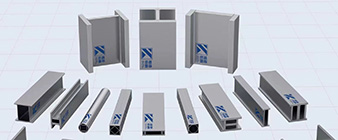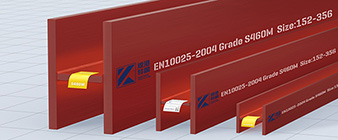The nuclear industry uses stainless steel in various components: reactors, heat exchangers, turbines, radioactive sludge tanks, etc. The components used are usually made of stainless steel. This material has maximum corrosion resistance, long service life and therefore High reliability and almost no maintenance required.
Due to the special nature of the nuclear environment, the most common stainless steel grades are 1.4307 (304L) and especially 1.4404 (316L). Sometimes applications also require higher austenitic grades or high yield strength grades, such as duplex stainless steels.
In addition to the grade, the maximum cobalt content required for stainless steel has serious implications for the melting of the raw material itself. The recycling rate of stainless steel reaches 95%, most of which comes from scrap. The tighter the cobalt content limit, the less scrap can be used, so the material becomes more expensive and harder to find. Quality often imposes further restrictions on chemical composition. In particular, there may be limits to the amount of cobalt it contains. Generally a maximum content of 0.2% is acceptable, but sometimes the maximum content can be limited to 0.05%. This is because cobalt contains an isotope that becomes radioactive and deteriorates when irradiated by nuclear material.

Due to the nature of the application, quality standards are the most stringent. Huanggang Special Steel has extensive experience in handling the production of steel sections and components for the nuclear industry.
Each project has its own specific requirements: a production plan is jointly agreed with the customer and each production step and associated procedures are carefully defined. This includes non-destructive testing (NDT), which is strictly specified in the final document and will be included in the life cycle record.
Quality departmentSuch products follow specialized production processes and are accompanied by specially designated and certified project managers. and production departments are trained and accustomed to handle the production of profiles through enhanced controls, inspections and associated paperwork (including waiting points and witness points), third-party inspections – all of which are prerequisites for the nuclear industry.
Peak Kong Special Steel is able to use all of its available production technologies, working with customers to select the technology best suited for a specific application. The required profiles can be produced by hot rolling, hot extrusion or laser welding. Additionally, product tolerances can be further tightened using hot rolled, hot extruded or laser welded preforms followed by cold drawing to achieve the desired dimensions and tolerances.
The containment vessel is a key component of a nuclear power plant, responsible for securing the reactor core and preventing the release of radioactive materials. These vessels must be able to withstand high pressures, temperatures and radiation levels, which is why they are built with materials that can withstand these extreme conditions. Stainless steel is the material of choice for building nuclear reactor containments due to its excellent strength, durability and corrosion resistance.
Piping systems are used in nuclear reactors to move coolant, fuel, and other materials throughout the reactor. These piping systems must be able to withstand the high pressures and temperatures, as well as the corrosive effects of radioactive materials flowing through them. Stainless steel is the material of choice for nuclear reactor piping systems due to its high corrosion resistance.
Stainless steel piping systems are manufactured from high-quality, corrosion-resistant stainless steel alloys and are designed to withstand the harsh environment found in nuclear reactors. These alloys are resistant to pitting and crevice corrosion that occurs when the material comes into contact with radioactive liquids. Stainless steel piping also helps maintain the integrity of the system, preventing leaks and other issues that could lead to dangerous situations.
Fuel rods surround the nuclear fuel pellets and are responsible for containing the fuel and protecting it from the reactor environment. The materials used to make the poles must be strong, durable, resistant to corrosion, radiation and extreme temperatures. Stainless steel is used as fuel rod material due to its excellent mechanical properties and corrosion resistance.
Stainless steel fuel rods help maintain fuel integrity, thereby reducing the risk of a nuclear accident. Stainless steel’s strength and durability also make it an ideal material for fuel rods, as it can withstand the extreme temperatures and pressures found in nuclear reactors.
Stainless steel is also used in the construction of nuclear waste storage tanks. Due to its high corrosion resistance, it is an ideal material for storing highly corrosive radioactive waste. Stainless steel storage tanks help ensure the safe containment and transport of radioactive waste.
In addition to concrete, many structural load-bearing components are made of stainless steel structural profiles, such as beams, channels, angles and hollow profiles. This is valid for the reactor core and all surrounding services, such as fuel rod storage and preparation. There are several structural profiles on the market that can only be supplied by welding, which has led to the nuclear industry placing additional safety and quality requirements on laser welded structural components. Laser welding technology is fully accepted and complies with the requirements for the production of profiles and parts for the global nuclear industry.

Stainless steel angle iron

Stainless steel unequal angle iron

Stainless steel I-beam

Stainless steel H-shaped steel

Stainless steel channel steel

Stainless steel T-shaped steel
Overall, stainless steel is an important material for the nuclear industry due to its exceptional strength, durability, and resistance to extreme temperatures and radiation. Stainless steel is used in the construction of containments, piping systems, fuel cladding, storage tanks and load-bearing structures, as well as all critical components of nuclear reactors.
- The application of stainless steel in the nuclear industry helps ensure the safety and reliability of nuclear reactors, prevent accidents and protect the environment.
- As the demand for clean and sustainable energy sources such as nuclear power continues to grow, the use of stainless steel in nuclear power plants is likely to increase.
Peak Kong Special Steel is committed to the research and development of stainless steel profiles in the nuclear industry, providing technology, software and services. Welcome to consult and negotiate.
-
2024-9-27 What are the typical applications of 318LN (1.4462) duplex stainless steel structural profiles?
-
 2024-9-20 1.4404 stainless steel profiles in construction engineering innovative applications
2024-9-20 1.4404 stainless steel profiles in construction engineering innovative applications -
 2024-7-17 S460 high strength structural steel Sections
2024-7-17 S460 high strength structural steel Sections -
 2024-9-20 Ti Gr 7/3.7235/UNS R52400 Application of structural profiles in chemical energy
2024-9-20 Ti Gr 7/3.7235/UNS R52400 Application of structural profiles in chemical energy -
 2024-9-21 High strength S690 steel VS 960 steel
2024-9-21 High strength S690 steel VS 960 steel -
 2024-9-24 EN standard 1.4401 stainless steel structural hollow Sections
2024-9-24 EN standard 1.4401 stainless steel structural hollow Sections -
 2024-9-25 254SMO vs. UNS S31254 Super Stainless Steel for Structural Beams and Columns
2024-9-25 254SMO vs. UNS S31254 Super Stainless Steel for Structural Beams and Columns



